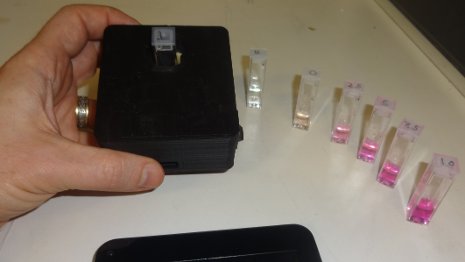Joshua Pearce
See the following -
Obliterate the Cost of Consumer Products with Open Hardware
 If you're looking for free and open source designs to replicate on your desktop 3D printer, you have about two million choices. Because the open source ethic is rooted so deeply in the 3D printing community, many of the consumer products you would normally buy are already among those millions of predesigned products. You can download the designs and save a lot of money. My group has shown in studies in both 2013 (on a self-built 3D printer) and 2017 (on an out-of-the box 3D printer) that peer-to-peer sharing prosumers (producing consumers) gain an incredible return on investment: > 100% at minimum and more likely ~1000% by 3D printing products to offset purchases only once a week...
If you're looking for free and open source designs to replicate on your desktop 3D printer, you have about two million choices. Because the open source ethic is rooted so deeply in the 3D printing community, many of the consumer products you would normally buy are already among those millions of predesigned products. You can download the designs and save a lot of money. My group has shown in studies in both 2013 (on a self-built 3D printer) and 2017 (on an out-of-the box 3D printer) that peer-to-peer sharing prosumers (producing consumers) gain an incredible return on investment: > 100% at minimum and more likely ~1000% by 3D printing products to offset purchases only once a week...
- Login to post comments
Open Source Powers The United Nations' Sustainability Goals
 Although the United Nations (UN) has previously spoken well of open source development, several recent events show the UN taking definitive actions to introduce the entire world to the open source way. In July, the UN’s Economic and Social Council (ECOSOC) adopted a draft resolution introduced by the representative of Pakistan titled Open source technologies for sustainable development. ECOSOC noted the availability of open source technologies that can contribute to the Sustainable Development Goals (SDGs). The council invited the Secretary-General to “develop specific proposals on ways to better leverage open source technologies for sustainable development based on inputs from interested Member States and other stakeholders.”
Although the United Nations (UN) has previously spoken well of open source development, several recent events show the UN taking definitive actions to introduce the entire world to the open source way. In July, the UN’s Economic and Social Council (ECOSOC) adopted a draft resolution introduced by the representative of Pakistan titled Open source technologies for sustainable development. ECOSOC noted the availability of open source technologies that can contribute to the Sustainable Development Goals (SDGs). The council invited the Secretary-General to “develop specific proposals on ways to better leverage open source technologies for sustainable development based on inputs from interested Member States and other stakeholders.”
- Login to post comments
Open Source Tech Revolutionizes Water Pollution Testing Equipment
 High nitrate levels in water cause the dead zones in the world’s largest deltas. Using too much nitrogen fertilizer wastes resources and leads to nitrate in runoff and water wells and an excess of nitrate in drinking water is a health hazard to infants and harmful to many animals. Current portable nitrate testers range in price and accuracy, from ballpark data at low price points to several hundred dollars for a handheld photometer. This new design is palm-sized, interfaces with a free Android app, costs less than $65 to manufacture and uses green chemistry for a safer and more accurate testing procedure. “This is a Popeye-approved reagent methodology,” Pearce jokes, adding that the enzyme used in the test kit is found in spinach and other leafy greens. “We’re replacing a toxic heavy metal with something that you eat every day in your salad.”
High nitrate levels in water cause the dead zones in the world’s largest deltas. Using too much nitrogen fertilizer wastes resources and leads to nitrate in runoff and water wells and an excess of nitrate in drinking water is a health hazard to infants and harmful to many animals. Current portable nitrate testers range in price and accuracy, from ballpark data at low price points to several hundred dollars for a handheld photometer. This new design is palm-sized, interfaces with a free Android app, costs less than $65 to manufacture and uses green chemistry for a safer and more accurate testing procedure. “This is a Popeye-approved reagent methodology,” Pearce jokes, adding that the enzyme used in the test kit is found in spinach and other leafy greens. “We’re replacing a toxic heavy metal with something that you eat every day in your salad.”
- Login to post comments
Open Source Tools Provide An Economic Advantage For Science
 Free and open source software (FOSS) and the distributed digital manufacturing of free and open source hardware (FOSH) have shown great promise for developing custom scientific tools. For some time now, FOSH has provided scientists a high return on investment. In fact, my previous research in the Open Source Labreported substantial economic savings from using these technologies. However, the open source design paradigm has since grown by orders of magnitude; now, there are examples of open source technology for science in the vast majority of disciplines, and several resources, including the Journal of Open Hardware, are dedicated to publishing them.
Free and open source software (FOSS) and the distributed digital manufacturing of free and open source hardware (FOSH) have shown great promise for developing custom scientific tools. For some time now, FOSH has provided scientists a high return on investment. In fact, my previous research in the Open Source Labreported substantial economic savings from using these technologies. However, the open source design paradigm has since grown by orders of magnitude; now, there are examples of open source technology for science in the vast majority of disciplines, and several resources, including the Journal of Open Hardware, are dedicated to publishing them.
- Login to post comments
Openpump – An Open Source Syringe Pump With 3D Printing & Bioprinting Potential
Openpump, an open-source syringe pump made to dispense fluids over a set period of time, is just like the syringe pumps used to administer medication in hospitals and laboratory environments. Most often used to perform chemical or biomedical research, pumps like this open-source version could easily be used for 3D printing extrusion of paste or as part of a 3D bioprinter for outputting biological materials...
- Login to post comments
The National Science Foundation Bets Big On Open Source Platforms
 The National Science Foundation (NSF) wants to grow the community of researchers who develop and contribute to open source and enable pathways for collaboration that lead to new technologies that have broad impacts on society...[NSF] just announced US $21 million to fund open source development through a new program: Pathways to Enable Open-Source Ecosystems (PEOSE).
The National Science Foundation (NSF) wants to grow the community of researchers who develop and contribute to open source and enable pathways for collaboration that lead to new technologies that have broad impacts on society...[NSF] just announced US $21 million to fund open source development through a new program: Pathways to Enable Open-Source Ecosystems (PEOSE).
- Login to post comments
Why Now Is A Great Time To Consider A Career In Open Source Hardware
 Twenty years or so ago, almost no one even knew what open source hardware was, let alone planned a career around it. In 2000, for example, out of the more than 2 million academic papers published that year in the entire world, only seven articles even mentioned "open source hardware" at all. When I first wrote Open-Source Lab, I'd collected every example (only a few dozen) and could easily keep up and read every open hardware article that got published to post them on a wiki. I am happy to report that is no longer physically possible. There have already been over 1,500 articles that discuss "open source hardware" this year, and I am sure many more will be out by year's end. Open source hardware is now a field of its own, with a few journals dedicated to it specifically (for example, HardwareX and the Journal of Open Hardware). In a wide range of fields, dozens of traditional journals now routinely cover the latest open hardware developments.
Twenty years or so ago, almost no one even knew what open source hardware was, let alone planned a career around it. In 2000, for example, out of the more than 2 million academic papers published that year in the entire world, only seven articles even mentioned "open source hardware" at all. When I first wrote Open-Source Lab, I'd collected every example (only a few dozen) and could easily keep up and read every open hardware article that got published to post them on a wiki. I am happy to report that is no longer physically possible. There have already been over 1,500 articles that discuss "open source hardware" this year, and I am sure many more will be out by year's end. Open source hardware is now a field of its own, with a few journals dedicated to it specifically (for example, HardwareX and the Journal of Open Hardware). In a wide range of fields, dozens of traditional journals now routinely cover the latest open hardware developments.
- Login to post comments